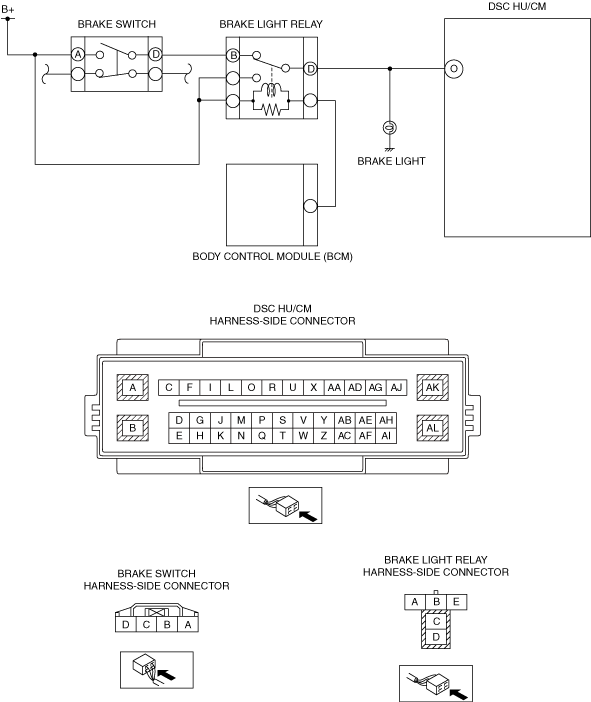|
1
|
INSPECT BRAKE LIGHT RELAY VOLTAGE
• Remove the brake light relay.
• Measure the voltage between brake light relay terminal B (wiring harness-side) and body ground.
• Is the voltage within followings?
-
― Brake pedal depressed: B+
― Brake pedal released: 1.0 V or less
|
Yes
|
Go to Step 4.
|
|
No
|
• If it is B+ under any condition, then go to the next step.
• If it is 1.0 V or less under any condition, then go to Step 3.
|
|
2
|
INSPECT BRAKE SWITCH
• Is the brake switch normal?
|
Yes
|
Refer to the wiring diagram and verify whether or not there is a common connector between brake switch terminal D and brake light relay terminal B.
If there is a common connector:
• Determine the malfunctioning part by inspecting the common connector and the terminal for corrosion, damage, or pin disconnection, and the common wiring harness for a short to power circuit.
• Repair or replace the malfunctioning part.
If there is no common connector:
• Repair or replace the wiring harness which has a short to power circuit.
Go to Step 7.
|
|
No
|
Replace the brake switch, then go to Step 7.
|
|
3
|
INSPECT BRAKE SWITCH
• Is the brake switch normal?
|
Yes
|
Refer to the wiring diagram and verify whether or not there is a common connector between brake switch terminal D and brake light relay terminal B.
If there is a common connector:
• Determine the malfunctioning part by inspecting the common connector and the terminal for corrosion, damage, or pin disconnection, and the common wiring harness for an open or short to ground circuit.
• Repair or replace the malfunctioning part.
If there is no common connector:
• Repair or replace the wiring harness which has an open or short to ground circuit.
Go to Step 7.
|
|
No
|
Replace the brake switch, then go to Step 7.
|
|
4
|
INSPECT BRAKE LIGHT RELAY
• Remove the brake light relay.
• Inspect brake light relay.
• Is the brake light relay normal?
|
Yes
|
Go to the next step.
|
|
No
|
Replace the brake light relay, then go to Step 7.
|
|
5
|
INSPECT WIRING HARNESS BETWEEN BRAKE LIGHT RELAY AND DSC HU/CM FOR OPEN OR SHORT CIRCUIT
• Disconnect the DSC HU/CM connector.
• Measure the voltage between DSC HU/CM terminal O (wiring harness-side) and body ground.
• Is the voltage within followings?
-
― Brake pedal depressed: B+
― Brake pedal released: 1.0 V or less
|
Yes
|
Go to the next step.
|
|
No
|
• If it is B+ under any condition, refer to the wiring diagram and verify whether or not there is a common connector between brake light relay terminal D and DSC HU/CM terminal O.
If there is a common connector:
-
• Determine the malfunctioning part by inspecting the common connector and the terminal for corrosion, damage, or pin disconnection, and the common wiring harness for a short to power circuit.
• Repair or replace the malfunctioning part.
If there is no common connector:
-
• Repair or replace the wiring harness which has a short to power circuit.
• If it is 1.0 V or less under any condition, refer to the wiring diagram and verify whether or not there is a common connector between brake light relay terminal D and DSC HU/CM terminal O.
If there is a common connector:
-
• Determine the malfunctioning part by inspecting the common connector and the terminal for corrosion, damage, or pin disconnection, and the common wiring harness for an open or short to ground circuit.
• Repair or replace the malfunctioning part.
If there is no common connector:
-
• Repair or replace the wiring harness which has an open or short to ground circuit.
• Go to Step 7.
|
|
6
|
VERIFY BODY CONTROL MODULE (BCM) DTC
• Using the M-MDS, perform the body control module (BCM) DTC inspection.
• Are any DTCs present?
|
Yes
|
Go to the applicable DTC inspection.
DTC troubleshooting completed, then go to the next step.
|
|
No
|
Go to the next step.
|
|
7
|
VERIFY DTC TROUBLESHOOTING COMPLETED
• Using the M-MDS, clear the DTC from the DSC HU/CM.
• Using the M-MDS, perform the DSC HU/CM DTC inspection.
• Is the same Pending DTC present?
|
Yes
|
Repeat the inspection from Step 1.
If the malfunction recurs, replace the DSC HU/CM, then go to the next step.
|
|
No
|
Go to the next step.
|
|
8
|
VERIFY NO DTC IS PRESENT
• Are any DTCs present?
|
Yes
|
Go to the applicable DTC inspection.
|
|
No
|
DTC troubleshooting completed.
|
